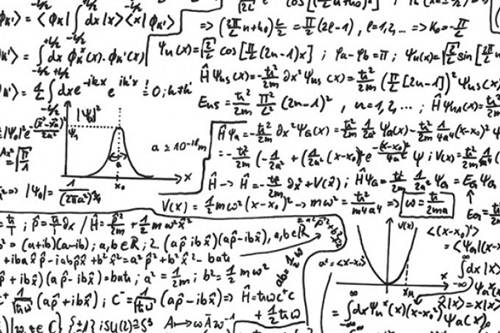10 Quantum Truths About Our Universe
From the moment it was discovered that the macroscopic, classical rules that dictated electricity, magnetism and light didn’t necessarily apply to the subatomic scales, an entirely new view of the Universe became open to mankind. This quantum picture is much larger and all-encompassing than most people understand, including many specialists. Here are ten basics of quantum mechanics that may make you re-examine how you picture our Universe, on the smallest scales and beyond. Check out these cool quantum truths about our Universe:
10. Schrödinger’s Cat Is Either Dead Or Alive, Not Both

To start off this list of quantum truths about our Universe, let us start by informing you that it was not well-understood in the early days of quantum mechanics, but the quantum function of macroscopic objects decays very fast. This “decoherence” is due to repeated interactions with the environment which are, in moderately warm and compact places like those needed for life, impossible to avoid. This demonstrates that what we consider of as a measurement doesn’t require a human; just interacting with the environment counts. It also demonstrates why bringing large objects into superposition of two distinct states is therefore very difficult and the superposition fades quickly.
The heavy object that has so far been brought into a superposition of locations is a carbon-60 molecule while the most pretentious have proposed to do this test for viruses or even heavier creatures like bacteria. Thus, the paradox that Schrödinger’s cat once raised – the transfer of a quantum superposition (the decaying atom) to a large object (the cat) – has been solved. We now understand that while small things like atoms can exist in superposition for long amounts of time, a large object would settle very rapidly in one particular state. That’s why we never observe cats that are both dead and alive.
9. But They Control The Small Scales

In quantum mechanics, each particle is also a wave and each wave is also a particle. The conclusions of quantum mechanics become very obvious once one observes a particle on distances that are similar to the associated wavelength. This is why atomic and subatomic physics cannot be explained without quantum mechanics, whereas planetary orbits are definitely unchanged by quantum action.
8. Quantum Impacts Are Not Necessarily Small

We do not usually see quantum effects on long distances because the necessary correlations are very fragile. Treat them carefully enough, however, and quantum effects can continue for long distances. Photons have for example been entangled over divisions as much as some hundreds of kilometers. In Bose-Einstein condensates, a degenerate state of matter got at cold temperatures, up to some million of atoms has been induced into one coherent quantum state. And lastly, some researchers even accept that dark matter may have quantum impacts which span across entire galaxies.
7. It’s All About Uncertainty

The fundamental postulate of quantum mechanics is that there are pairs of visible that cannot simultaneously be measured, like for example the position and momentum of a particle. The quantum truths about our Universe is that pairs are named “conjugate variables,” and the impossibility to measure both their values exactly is what makes all the distinction between a quantized and a non-quantized theory. In quantum mechanics, this theory is fundamental, not due to experimental shortcomings. One of the most strange manifestations of this is the uncertainty of energy and time, which suggests that unstable particles have naturally uncertain masses, thanks to Einstein’s E=mc2.
6. Einstein Didn’t Disprove It

Opposite to popular opinion, Einstein was not a quantum mechanics denier. He couldn’t probably be – the theory was so successful first on that no serious specialist could dismiss it. In fact, it was his Nobel-winning discovery of the photoelectric impact, proving that photons behaved as particles as well as waves that were one of the core revelations of quantum mechanics. Einstein instead disputed that the theory was incomplete, and believed the natural randomness of quantum processes must have a profound explanation. It was not that he believed the randomness was wrong, he just believed that this wasn’t the finish of the story. For an excellent exposition of Einstein’s views on quantum mechanics, I advise George Musser’s article “What Einstein Really Thought about Quantum Mechanics”.
5. Quantum Physics An Intense Research Field

The theory started more than a century ago. But many viewpoints of it became testable only with contemporary technology. Quantum optics, quantum computing, quantum thermodynamics, quantum cryptography, quantum information, and quantum metrology are all lately formed and immediately very intense research areas. With the new abilities earned with these technologies, investment in the foundations of quantum mechanics has been reignited.
4. There Is No Weird Action At A Distance

Nowhere in quantum mechanics is data ever sent non-locally, so that it jumps over a stretch of space without having to go through all positions in between. Entanglement is itself non-local, but it doesn’t do any action – it is an association that is not connected to the non-local change of information or any other visible. When you understand a research where two entangled photons are separated by a great distance and then the spin of each one is measured, there is no data being transferred faster than the speed of light. In fact, if you try to bring the results of two observations together, that data can only travel at the speed of light, no faster! What forms “information” was a great source of uncertainty in the early days of quantum mechanics, but we know today that the theory can be made perfectly fit with Einstein’s Theory of Special Relativity in which data cannot be shifted faster than the speed of light. That’s one among the most significant quantum truths about our Universe.
3. Entanglement Not The Identical As Superposition

A quantum superposition is the capability of a system to be in two distinct states at the same time, and yet, when measured, one constantly finds a particular state and never a superposition. Entanglement, on the other hand, is an association between two or more parts of a system – something completely different. Superposition are not basic: whether a state is or isn’t a superposition depends on what you need to measure. A state can, for example, be in a superposition of positions and not in a superposition of moment – so the entire concept is vague. Entanglement, on the other hand, is unambiguous: it is a fundamental property of each system and the best-known measure of a system’s quantum-ness.
2. Quantization Doesn’t Surely Imply Discreteness

“Quanta” are discrete particles, by definition, but not everything becomes chunky or inseparable on short scales. The quantum truths about our Universe are that electromagnetic waves are composed of quanta called “photons,” so the waves can be considered of as being discretized. And electron shells around the atomic nucleus can just have clear discrete radii. But other particle characteristics do not become discrete even in a quantum theory. The state of electrons in the conducting band of a metal, for example, is not discrete – the electron can fill any continuous position within the band.
1. All Is Quantum

Now we know that some things are quantum mechanical and others are not. Everything follows the same laws of quantum mechanics – it’s just that quantum effects of large objects are very hard to see. That is why quantum mechanics was a latecomer to the evolution of theoretical physics: it was not till physicists had to justify why electrons sit on shells around the atomic nucleus that quantum mechanics became essential to make accurate predictions.
10 Quantum Truths About Our Universe
- All Is Quantum
- Quantization Doesn’t Surely Imply Discreteness
- Entanglement Not The Identical As Superposition
- There Is No Weird Action At A Distance
- Quantum Physics An Intense Research Field
- Einstein Didn’t Disprove It
- It’s All About Uncertainty
- Quantum Impacts Are Not Necessarily Small
- But They Control The Small Scales
- Schrödinger’s Cat Is Either Dead Or Alive, Not Both
Written by: A.C. Claudia



No comments